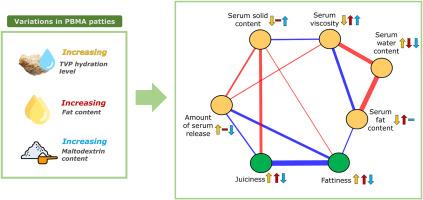植物性肉类类似物的多汁性是由血清释放而不是血清成分和粘度驱动的
IF 11
1区 农林科学
Q1 CHEMISTRY, APPLIED
引用次数: 0
摘要
多汁和脂肪是消费者接受植物性肉类模拟物(PBMA)馅饼的关键驱动因素。先前的研究表明,这些特性与咀嚼过程中释放的血清(可表达液)的量密切相关,而血清特性的作用尚不清楚。本研究旨在揭示血清数量、成分和粘度对PBMA肉饼多汁性和脂肪性的影响,并确定这些感官属性的主要驱动因素。采用因子设计(2 × 3 × 2),通过不同原料肉饼配方的水合化植物蛋白(TVPs)水平、脂肪和麦芽糖糊精含量系统地改变血清特性。结果表明,血清释放量在8% ~ 20% w/w之间变化,血清含水量在29% ~ 85% w/w之间变化,脂肪含量在12% ~ 65% w/w之间变化,血清粘度在6 ~ 360 mPa⋅s之间变化。正如预期的那样,多汁性和脂肪含量随着血清释放量的增加而增加。血清粘度和脂肪含量的系统性变化使其影响得以分离。单独增加血清粘度对多汁性和脂肪没有影响。脂肪含量随血清脂肪含量的增加而增加,而多汁性不受影响。因此,脂肪不仅通过其对粘度的影响,而且可能通过其他影响,如润滑,对口感属性做出了贡献。这些结果表明,多汁和脂肪的产生机制不同。PBMA肉饼的多汁性主要受压缩后血清释放量的影响,而不是受血清成分和黏度的影响,而脂肪含量则受血清量和脂肪含量的影响。本文章由计算机程序翻译,如有差异,请以英文原文为准。

Juiciness of plant-based meat analogues is driven by serum release rather than serum composition and viscosity
Juiciness and fattiness are key drivers of consumer acceptance for plant-based meat analogue (PBMA) patties. Previous studies showed that these attributes correlated strongly with the amount of released serum (expressible fluid) during mastication, while the role of serum properties remains unclear. This study aimed to reveal the effects of serum quantity, composition and viscosity on juiciness and fattiness of PBMA patties, identifying the main drivers for these sensory attributes. A factorial design (2 × 3 × 2) was used to systematically vary serum properties by varying raw patty formulations in hydration level of textured vegetable proteins (TVPs), fat and maltodextrin content. This resulted in patties which varied in quantity of serum release from 8 to 20 %w/w, and varied in serum water content from 29 to 85 %w/w, fat content from 12 to 65 %w/w, and serum viscosity from 6 to 360 mPa⋅s. As expected, juiciness and fattiness increased with increasing serum release. Systematic variation in serum viscosity and fat content allowed separation of their effects. Increasing serum viscosity alone did not affect juiciness and fattiness. Fattiness rose with increasing serum fat content, while juiciness remained unaffected. Fat thus contributed to those mouthfeel attributes not only through its effect on viscosity, but potentially also through other effects, such as lubrication. These results showed that juiciness and fattiness arise from different mechanisms. Juiciness of PBMA patties was primarily driven by the quantity of serum released upon compression rather than serum composition and viscosity, while fattiness was influenced by both serum quantity and fat content.
求助全文
通过发布文献求助,成功后即可免费获取论文全文。
去求助
来源期刊

Food Hydrocolloids
工程技术-食品科技
CiteScore
19.90
自引率
14.00%
发文量
871
审稿时长
37 days
期刊介绍:
Food Hydrocolloids publishes original and innovative research focused on the characterization, functional properties, and applications of hydrocolloid materials used in food products. These hydrocolloids, defined as polysaccharides and proteins of commercial importance, are added to control aspects such as texture, stability, rheology, and sensory properties. The research's primary emphasis should be on the hydrocolloids themselves, with thorough descriptions of their source, nature, and physicochemical characteristics. Manuscripts are expected to clearly outline specific aims and objectives, include a fundamental discussion of research findings at the molecular level, and address the significance of the results. Studies on hydrocolloids in complex formulations should concentrate on their overall properties and mechanisms of action, while simple formulation development studies may not be considered for publication.
The main areas of interest are:
-Chemical and physicochemical characterisation
Thermal properties including glass transitions and conformational changes-
Rheological properties including viscosity, viscoelastic properties and gelation behaviour-
The influence on organoleptic properties-
Interfacial properties including stabilisation of dispersions, emulsions and foams-
Film forming properties with application to edible films and active packaging-
Encapsulation and controlled release of active compounds-
The influence on health including their role as dietary fibre-
Manipulation of hydrocolloid structure and functionality through chemical, biochemical and physical processes-
New hydrocolloids and hydrocolloid sources of commercial potential.
The Journal also publishes Review articles that provide an overview of the latest developments in topics of specific interest to researchers in this field of activity.
 求助内容:
求助内容: 应助结果提醒方式:
应助结果提醒方式:


